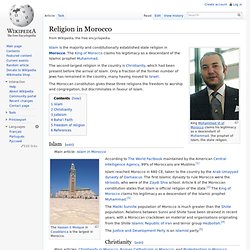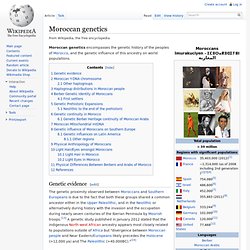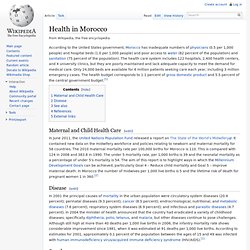

Demographics of Morocco. Demographics of Morocco, Data of FAO, year 2005 ; Number of inhabitants in thousands.

Foreign residents in Morocco by country of birth, in 1994 This article is about the demographic features of the population of Morocco, including population density, ethnicity, education level, health of the populace, economic status, religious affiliations and other aspects of the population. The population of Morocco is estimated in 2013 at 35 million. The overwhelming majority of Moroccans are of Arab-Berber descent,[1][2] whether they speak the Berber language or not. Part of Moroccans identify themselves as Berbers through the spoken language, through a mix of family/tribal/territorial ties, or through both.
Morocco is inhabited by Berbers (imazighen) since at least 5,000 years ago. About 95% of Moroccans are considered to be Sunni Muslims religiously or culturally. Population[edit] Source: Haut-Commissariat au Plan (HCP)[4] Total fertility rate. Demographics in Morocco. Religion in Morocco. Islam is the majority and constitutionally established state religion in Morocco.

The King of Morocco claims his legitimacy as a descendant of the Islamic prophet Muhammad. The second-largest religion in the country is Christianity, which had been present before the arrival of Islam. Only a fraction of the former number of Jews has remained in the country, many having moved to Israel. The Moroccan constitution gives these three religions the freedom to worship and congregation, but discriminates in favour of Islam. Islam[edit] According to The World Factbook maintained by the American Central Intelligence Agency, 99% of Moroccans are Muslims.[1] Religion in Morocco. Languages of Morocco. There are 12 to 15 million Berber speakers in Morocco, about 40 to 50% of the population.[8] French remains Morocco's unofficial third language, and is taught universally and serves as Morocco's primary language of commerce and economics; it is also widely used in education and government.

Morocco is a member of the Francophonie. Arabic[edit] In 1995 the number of native Arabic speakers in Morocco was approximately 18.8 million (65% of the total population), and 21 million including the Moroccan diaspora.[11] As a member of the Maghrebi Arabic grouping of dialects, Moroccan Arabic is similar to the dialects spoken in Mauritania, Algeria, Tunisia, and Libya (and also Maltese). The country shows a marked difference in urban and rural dialects. Modern Standard and Classical Arabic[edit] Moroccans learn Standard Arabic as a language. File:Morocco - Linguistic map.png. Languages in Morocco. Moroccan genetics. Moroccan genetics encompasses the genetic history of the peoples of Morocco, and the genetic influence of this ancestry on world populations.

Genetic evidence[edit] The genetic proximity observed between Moroccans and Southern Europeans is due to the fact that both these groups shared a common ancestor either in the Upper Paleolithic, and in the Neolithic or alternatively during history with the invasion and the occupation during nearly seven centuries of the Iberian Peninsula by Moorish troops.[13] A genetic study published in January 2012 stated that the indigenous North-west African ancestry appears most closely related to populations outside of Africa but "divergence between Moroccan people and Near Eastern/Europeans likely precedes the Holocene (>12,000 ya) and The Paleolithic (>40.000BC). "[14] Distribution of Y haplotype E-M81 E1b1b1b in North Africa, West Asia and Europe.
Moroccan Y-DNA chromosome[edit] Genetics in Morocco. List of cities in Morocco. Education in Morocco. Background of Education System[edit] It was in the year 1963 that education was made compulsory for all Moroccan children between the ages of 6 through 13[1] and during this time all subjects were Arabized in the first and second grades, while French was maintained as the language of instruction of maths and science in both primary and secondary levels.

Later, to meet the rising demand for secondary education in 1970s, Morocco imported French speaking teachers from countries such as France, Romania, and Bulgaria to teach maths and sciences, and Arab teachers to teach humanities and social studies. By 1989, Arabization of all subjects across all grades in both primary and secondary education was accomplished. However, French was maintained the medium of instruction for scientific subjects in technical and professional secondary schools, technical institutes and universities.[2]
Education in Morocco. Health in Morocco. According to the United States government, Morocco has inadequate numbers of physicians (0.5 per 1,000 people) and hospital beds (1.0 per 1,000 people) and poor access to water (82 percent of the population) and sanitation (75 percent of the population).

The health care system includes 122 hospitals, 2,400 health centers, and 4 university clinics, but they are poorly maintained and lack adequate capacity to meet the demand for medical care. Only 24,000 beds are available for 6 million patients seeking care each year, including 3 million emergency cases. The health budget corresponds to 1.1 percent of gross domestic product and 5.5 percent of the central government budget.[1] Maternal and Child Health Care[edit] In June 2011, the United Nations Population Fund released a report on The State of the World's Midwifery. Disease[edit] See also[edit] Healthcare in Morocco.